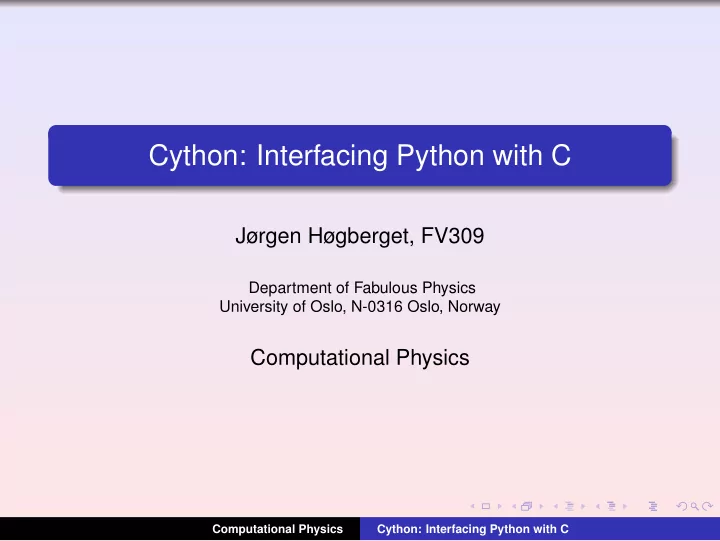

Cython: Interfacing Python with C Jørgen Høgberget, FV309 Department of Fabulous Physics University of Oslo, N-0316 Oslo, Norway Computational Physics Computational Physics Cython: Interfacing Python with C
Interfacing? Cython? Interfacing: Creating a bridge of communication between different programming languages. Why? Python objects (strings, integers, floats) are not general for all languages. The ’real world’ language analogue. We need something to interpret the python objects, translate them, and explain the translation to C. This is Cython’s job! The ’real world’ translator analogue. Computational Physics Cython: Interfacing Python with C
Why use interfacing? Python vs. C++ C is fast whereas Python is slow . C can be an abstract mess to newcomers, whereas Python is beautiful and intuitive (art). C code usually takes longer to implement (pointers, declarations, segmentation faults , compilation), whereas Python is straight forward with excellent error handling. Getting (large) C codes to be structured and provide a sufficient error feedback usually requires a high(er) understanding of the language. Expanding/altering a (large) Python code is very simple in comparison to C/C++. Computational Physics Cython: Interfacing Python with C
Summary, basic idea You take the best of two worlds and combine them to fit your needs . Computational Physics Cython: Interfacing Python with C
Illustrative example Computational Physics Cython: Interfacing Python with C
Illustrative example Computational Physics Cython: Interfacing Python with C
Illustrative example Computational Physics Cython: Interfacing Python with C
Cython? Why bother? Reduces program runtime by 50-100 times if done correctly, depending on the complexity of the code. Requires very little additional work: 90% of the job is writing the python code! All Cythonic statements are seperate lines: No need to alter the original code structures. Compilation is automatic, all you need to specify is a name. Cython fully supports the familiar Numpy arrays. Sections left without any Cython ’seasoning’ are run with Python. Computational Physics Cython: Interfacing Python with C
A small Python example: 42.5s runtime from numpy import * def calc ( ) : n = 10000000 s = 0 c = zeros ( n ) for i in range ( n ) : c [ i ] = 1; c [ i ] +=1; c [ i ] − =1; c [ i ] *=2; c [ i ] /=2; c [ i ] /= c [ i ] s += c [ i ] return s / n print calc ( ) Computational Physics Cython: Interfacing Python with C
The same thing in standard c++: 0.24s runtime double calc ( ) { int i , n ; double s ; n = 10000000; double * c = new double [ n ] ; for ( i = 0; i < n ; i ++) { c [ i ] = 1; c [ i ] += 1; c [ i ] − = 1; c [ i ] *= 2; c [ i ] /= 2; c [ i ] /= c [ i ] ; s += c [ i ] ; } return s / n ; } Computational Physics Cython: Interfacing Python with C
A small Cython example: 0.24s runtime import numpy as np cimport numpy as np cimport cython ctypedef np . f l o a t t DTYPE t @cython . boundscheck ( False ) cdef double calc ( ) : cdef int i , n cdef double s cdef np . ndarray [ DTYPE t ] c . . . (100% equivalent code ) . . . Computational Physics Cython: Interfacing Python with C
Cython strategy Strategy: Copy your Python code and rename it with .pyx Copy-paste the import statements. Assuming your Python code is bug-free, turn off array boundschecks. Declare variables used in the slow regions of the code. Remember: Profile your code. No need to cythonize everything. Computational Physics Cython: Interfacing Python with C
Compiling the linked library Copy-paste the setup.py file: from distutils.core import setup from distutils.extension import Extension from Cython.Distutils import build_ext numpy = "/local/lib/python2.5/site-packages/numpy/core/include/" setup( cmdclass = {’build_ext’: build_ext}, ext_modules = [Extension("my_lib", ["superfast.pyx"], include_dirs = [numpy])] ) Create the linked library by running the setup.py file. Then you may simply import it: ...$ python setup.py build_ext --inplace ...$ python -c "import my_lib" Computational Physics Cython: Interfacing Python with C
Example: Project1 FYS3150 C++ -O3, Python and Cython with n = 1000 scaled with 10 − 4 : C++ with O3 optimization: 1 . 88 s . Python: 110 s . Cython with one of the original functions cythonized: 2 . 4 s . Computational Physics Cython: Interfacing Python with C
Exp, sqrt, log etc. in Cython from l i b c . math cimport exp as c exp #RHS function and the corresponding exact s o l u t i o n of Poisson ’ s eq . cdef double f ( double x ) : return 100* c exp( − 10*x ) Computational Physics Cython: Interfacing Python with C
Profiling in Python >>> import profile >>> profile.run(’profile_me.main()’,sort=1) total time used: 30.6238 s 1000031 function calls in 19.126 CPU seconds Ordered by: internal time ncalls tottime ... percall filename:lineno(function) 1 10.265 ... 19.069 profile_me.py:8(speed_me_up) 1000000 8.731 ... 0.000 profile_me.py:5(<lambda>) 3 0.073 ... 0.024 :0(range) ... 1 0.000 0.000 prof..(set_boundaries) Do not bother optimizing set_boundaries() ..! Computational Physics Cython: Interfacing Python with C
Recommend
More recommend